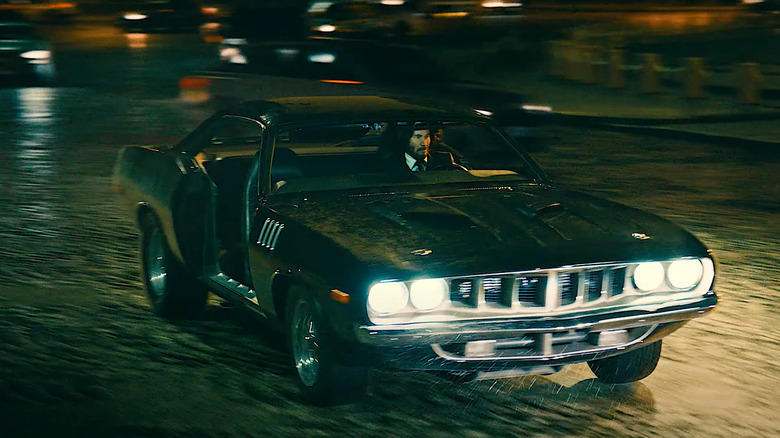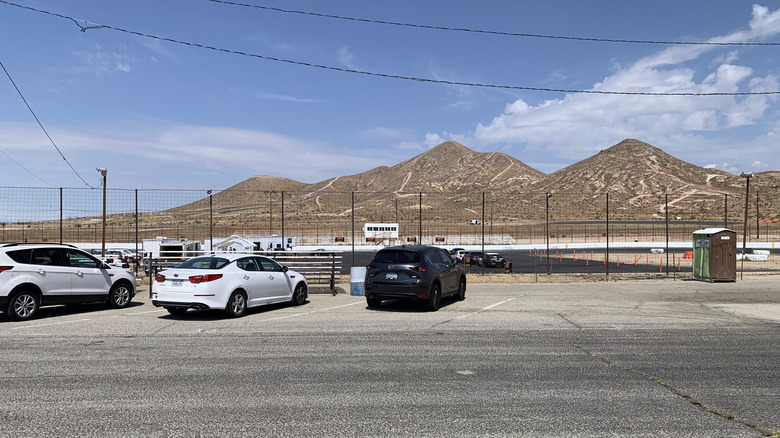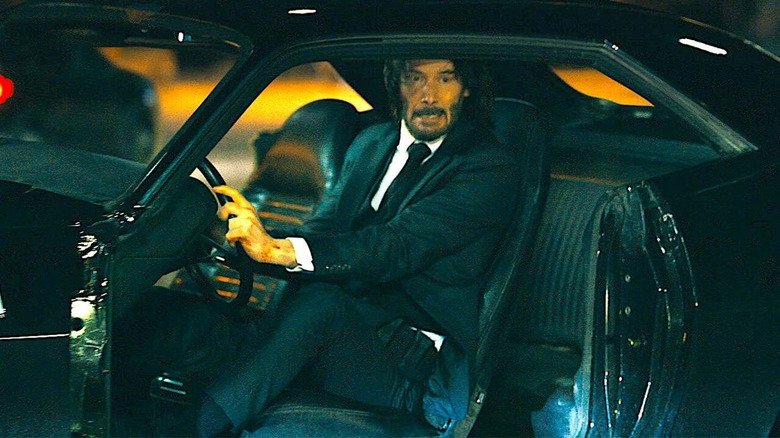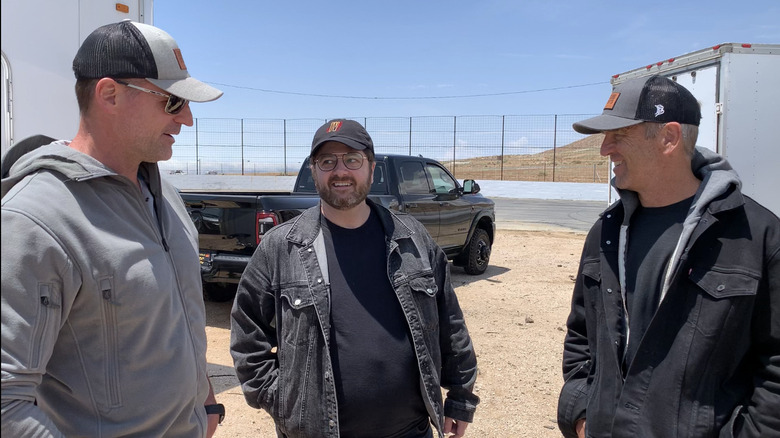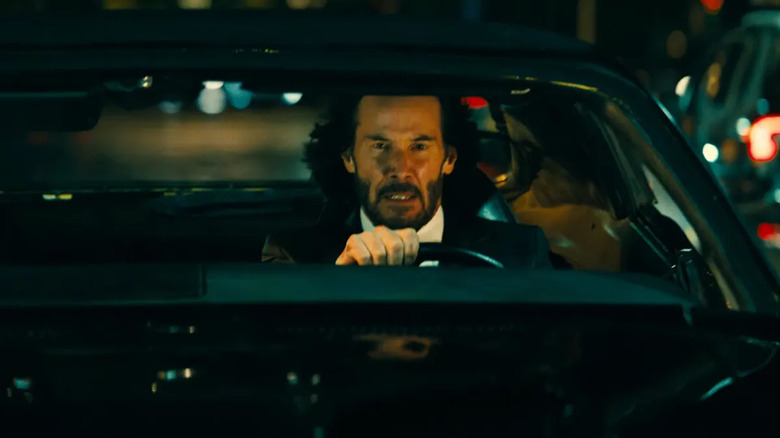The John Wick: Chapter 4 Stunt Coordinators Taught Me How To Drive Like Keanu Reeves
In the world of "John Wick," anything can be a weapon to a master assassin: a gun, a knife, a fist, a dog, a pencil. Add to that extensive list the motor vehicle; as Keanu Reeves' brooding killer hellbent on revenge has proved over four movies, he can attack an opponent with his car just as well as anything else.
This ability has been developed into a technique by the filmmakers and stunt coordinators behind the "John Wick" series that they've dubbed "car-fu," in which the car versus human sequences were choreographed like fight scenes. In order to pull these moments off, the "John Wick: Chapter 4" stunt team had to be expertly trained when it came to their driving skills.
Recently, I had the opportunity to receive a little car stunt training from the very people who helped build up Reeves' own driving abilities. This past weekend, "Chapter 4" stunt coordinators Scott Rogers and Stephen Dunlevy were on hand to supervise the stunt drivers of the Motion Picture Driving Clinic as they taught me and others how to drive like Keanu Reeves. The results may have been mixed, but the experience was just as thrilling (and thankfully not as deadly) as being in the "John Wick" universe.
'Wick' work at Willow Springs
My day began by hopping on a shuttle bus in Burbank, CA and driving about an hour north of Los Angeles to Rosamond, where the Willow Springs Raceway is located. As a guy who grew up in the Midwest and lived in New York City for 15-odd years, I was not prepared for being in the middle of the desert — long stretches of barren land surrounded the lonely group of racetracks, the wind whipped mightily throughout the entire time I was there, and I even spotted a real live desert fire ant (which are disconcertingly large and can both bite and sting).
Clearly, this is the best type of place to get the eye of the tiger when it comes to stunt training. Almost as soon as my colleagues and I were off the bus, we were introduced to six stunt cars. Sadly, these were not the cars from "John Wick: Chapter 4," but they were still pretty nifty — a group of automatic transmission sedans that had been modified with what the stuntpeople called the "stunt brake": a large metal brake on the far left side of the driver's seat. I quickly came to learn that this was essentially an e-brake, and when pushed would lock up the rear tires of the vehicle.
The technique of "locking up" tires is one of the basic building blocks of a lot of driving stunts that you see on screen. It allows the driver to slide a speeding car up to a predetermined mark (the term for a spot where the director, coordinator and/or cameraman wants a driver or actor to end up) and the tires make an exciting squeal in the process. It's also an important step in performing a "180," so named for the number of degrees a driver is spinning their vehicle around.
What's it like to drive like Keanu Reeves in #JohnWickChapter4? /Film's own @billbria got behind the wheel of a stunt car for a lesson in action hero car handling. pic.twitter.com/ZTYVYq8ZgY
— /Film (@slashfilm) June 14, 2023
Turning and burning
Before any of us were allowed to get behind the wheel, we took part in a stunt safety meeting run by the MPDC members, during which we were told exactly what we'd be doing and where, as well as what to do if something went awry (at this point, allow me to soothe your nerves, dear reader — the entire day went off without a hitch).
After that, we were put into the stunt cars and given a quick ride-along where we observed the MPDC drivers performing the very techniques we were expected to do immediately after. Barely a half-hour after arriving at the track, I found myself behind the wheel of a car frantically fumbling for the seatbelt and learning how to adjust the driver's seat (spoiler: the controls are on the side of the driver's door, a fact some of my colleagues learned too late, resulting in some awkward discomfort on their part).
Upon waiting patiently for the call of "action" over the walkie-talkie, I hit the gas, careening down the predetermined pathway toward two tall rubber cones that represented my mark. Learning how to use the stunt brake and slide into position came fairly quickly to me; much more challenging was mastering the 180. As one of my instructors pointed out, most untrained drivers instinctively think a great deal of maneuvering with the steering wheel is what's needed, but that's actually counterintuitive. What you want to do instead is turn the wheel about 45 degrees while locking up and braking, essentially bringing your elbow to your hip. The momentum of the car will do the rest, and you're likely to get a nice, clean whip around. That's precisely what happened by the end of the session for me, thanks to that key bit of advice.
Hangin' with Scott and Stephen
As the group of attendees invited to the track took turns learning these stunt driving techniques, the rest of us got to mill about while observing our colleagues. The overall mood of the day's events was one of relaxed enjoyment, as it was clear that the stunt people do what they do not just for a paycheck but because they have a genuine blast doing it, too.
When they weren't hanging out with their pals and co-workers, Rogers and Dunlevy made the rounds speaking to some of us informally about their experiences on "Chapter 4" as well as their views on stunt work in general. They discussed how they pulled off all those multiple people (including Wick himself) getting hit by cars in the film, using very similar techniques to the ones we were learning; essentially, stunt drivers were given a precise mark to hit which were typically just a few feet away from where the actor or stunt person was, with the camera's focal length closing the distance between them.
They also talked a little bit about how they put the Arc de Triomphe sequence together, as virtually none of it was shot at the actual Paris location for logistic reasons. Rogers stated that "in second unit alone, we shot three weeks," and that the bulk of the sequence was shot at an airport in Berlin with a marked-off area of tarmac standing in for the Arc. Yet as wild as that set piece is, Dunlevy admitted that the scene featuring the most stunt people at one time is the Osaka Continental attack, which featured 70 stunt performers and was its own logistical nightmare given all of the different languages spoken amongst the cast and crew. Overall, Rogers and Dunlevy were extremely chill, no-nonsense guys who seemed to love their work and those they work with.
Graduation day
During lunch, the MPDC crew did a few hairpin turns and 180s around the barrels on the track for us while we ate. Just as my colleagues and I were bravely attempting to keep our napkins from flying off into the breeze, we were told that we were now expected to compete against each other in a series of time trials. The course was thus: Drive around two barrels as fast as we can before coming to a stop inside a "box" of cones without knocking any over.
In addition to the nerve-wracking feeling of having to compete using skills I'd just learned, I also felt like a student having to take a test that I hadn't studied properly for. I still gave it my best, careening around the barrels while attempting to demonstrate my newfound skills at the 180. While I'm proud to say I didn't knock any cones over, I must sadly admit that I was not the fastest on the track that day, managing to complete the course at a personal best time of about 15 seconds.
Still, I ended my time at Willow Springs feeling like I'd been given a big head start on stunt driving, and while Keanu Reeves may be just a little ahead of me (okay, or a lot ahead), I know that at least I now have some extra skills behind the wheel with which to avoid these crazy L.A. drivers.
"John Wick: Chapter 4" is now available on digital, 4K Ultra HD & Blu-Ray.
